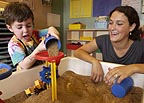November 15, 2005
Child development experts at SIUC offer gift suggestions Toys that inspire creativity help little ones develop
CARBONDALE, ILL -- Turns out there are perfectly logical reasons why kids would rather play with the box than the toy.But that doesn’t mean some toys aren’t just as stimulating to young, developing minds.
Child development specialists at Southern Illinois University Carbondale say parents should go for a balance of simplicity and high-tech when shopping for their young children this holiday season. From infants to about 5 years old, kids learn and are stimulated in a variety of ways. The gift-giving season is a chance to give a child insight into the physical world, as well as a smile.
In general, infants and toddlers need physical stimulation – visual, auditory and tactile. Toys that light up, make noise or can be mouthed all do the trick.
For preschoolers, toys that encourage imagination, social role-playing and realistic life scenarios are the ticket.
And it doesn’t have to be expensive.
“You don’t have to spend a lot of money to stimulate your child,” said Melissa Viernow, a master infant and toddler teacher at SIUC’s Child Development Laboratory. “You need a balance between toys and kids learning to explore on their own.”
So why do they play with the box? Viernow says children have an innate urge to be creative.
“With a box, you can build with it, paint it, drive through it or just be in it,” Viernow said. “They like that big refrigerator box full of packing peanuts because it gives them freedom, it gives them choice.”
Old pots and pans, paper towel rollers and dress-up clothes make stimulating items as well, allowing children to create imaginary situations based on real life. Parents might hesitate to give such seemingly disposable items as Christmas presents. But Viernow said some store-purchased toys offer similar characteristics.
Look for qualities such as the toy’s possible parallel use with other toys and open-ended, rather than single-purpose use. A puzzle, for example, is a fine toy but can only be used one way.
With older pre-school-age children, versatility is the key. Dolls, which can be used in a variety of imaginative role-playing games, and building toys, which encourage planning and creativity, are always good choices.
If nothing else, consider a toy that is like a box.
“Get a toy tent instead of a box,” Viernow suggests. “They can be in there and take things in there with them. They can use it many different ways.”
Infants and toddlers receive lots of information from simple sights, sounds and textures. Viernow said many store-purchased toys are strong contenders in those areas.
“Toys that light up, are movable, make sounds and or have a texture are good choices,” she said. “Many of the more technical electronic toys make sounds and light up. In a way, they’re kind of nice.
“But you need a balance. You don’t want just flashy toys in front of them,” she said. “With infants, it can be as easy as hanging a ball on a string and letting them bat it around. It does the same thing every time they hit it. That’s how they learn about the natural world and it gives them instant gratification.”
Beth Wilson, a master teacher in the early and late pre-school level at the Child Development Laboratory, said boys and girls of that age are motivated by the same needs for social and emotional growth.
“Little boys like to cuddle and hold a doll and little girls like to dress up like a police officer,” she said. “They are learning cooperative skills and how to be adults.”
Viernow said toy choices are perhaps more important now than ever before. With so many marketing campaigns targeting children directly through specialized media, such as all-cartoon networks, parents should make sure children exercise their creative muscles.
“Kids are so bombarded. They don’t always know how to entertain themselves anymore,” Viernow said. “It’s just our culture right now. “
And some toys tend to baby-sit children, rather than stimulate them. Viernow puts video games in that category, though again points to that key term – balance.
“We have to be careful that we’re not buying our kids pacifiers,” she said. “If they can create with it, make sounds with it or add it to something else, you will see a reaction from the child.”
Holidays also can be a time to deal with another problematic aspect of toys: having too many. Families with several children and large extended families buying them gifts can end up with a glut.
Two strategies for dealing with this include limiting the number of toys to which children have access at any given time and donating some to charity during the holiday season. Viernow suggested parents make a few toys available on a rotating basis, which will help keep the child from becoming saturated and allow them to get more pleasure out of the toys.
“It’s also a good time to talk to them about children who don’t have toys,” she said. “It’s a good time to box up some toys and donate them to charity. It helps them become responsible.”
Serving others and enhancing outreach activities are among the goals of Southern at 150: Building Excellence Through Commitment, the blueprint the University is following as it approaches its 150th anniversary in 2019.
(Caption: Having fun – Daniel, a 4-year-old who attends the Southern Illinois University Carbondale Child Development Laboratory, pours sand into a toy as his teacher, Beth Wilson, looks on. Toys that stimulate the senses of touch, sight and sound are good choices for pre-school-aged children such as Daniel.)
Photo by Russell Bailey

